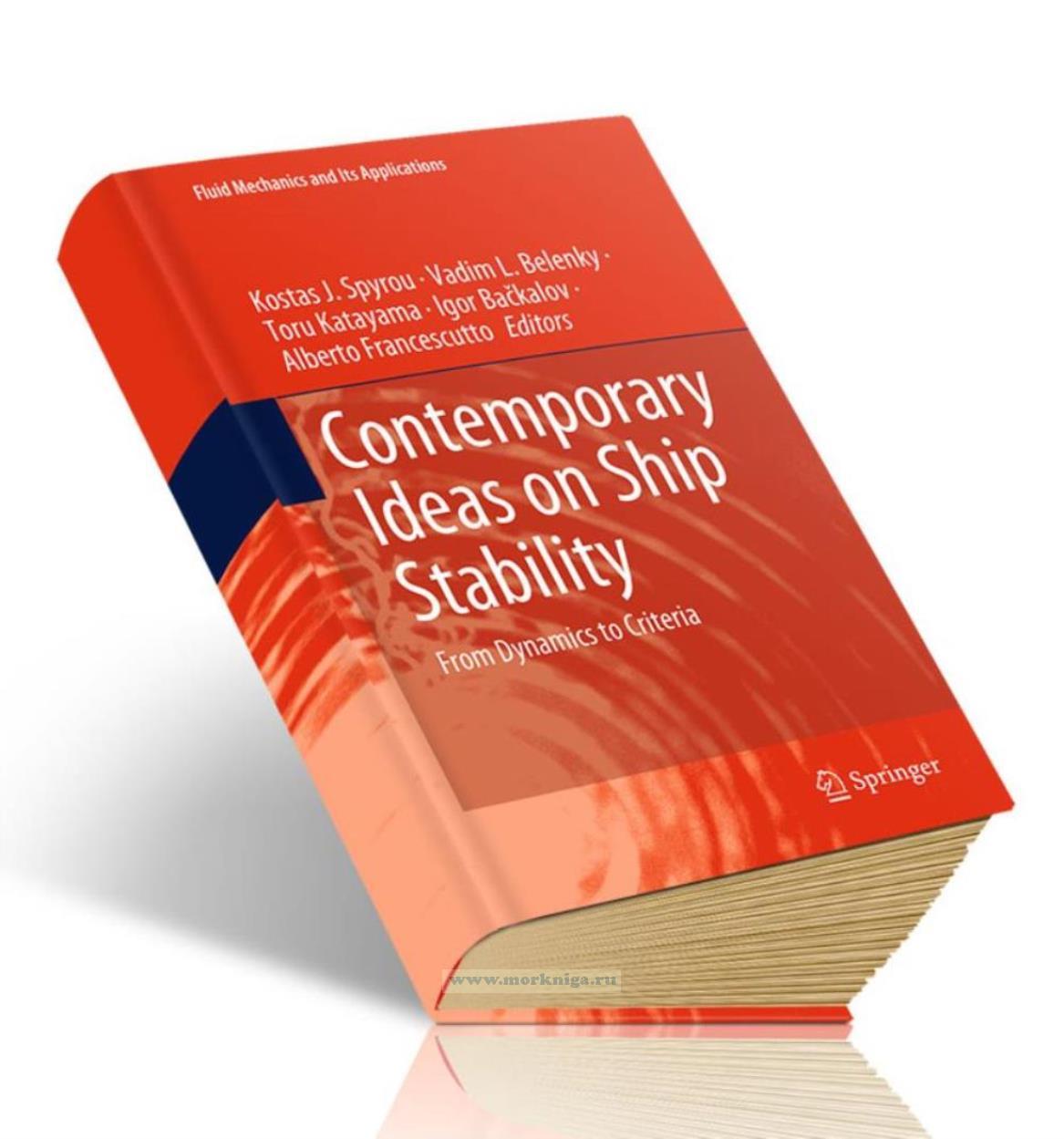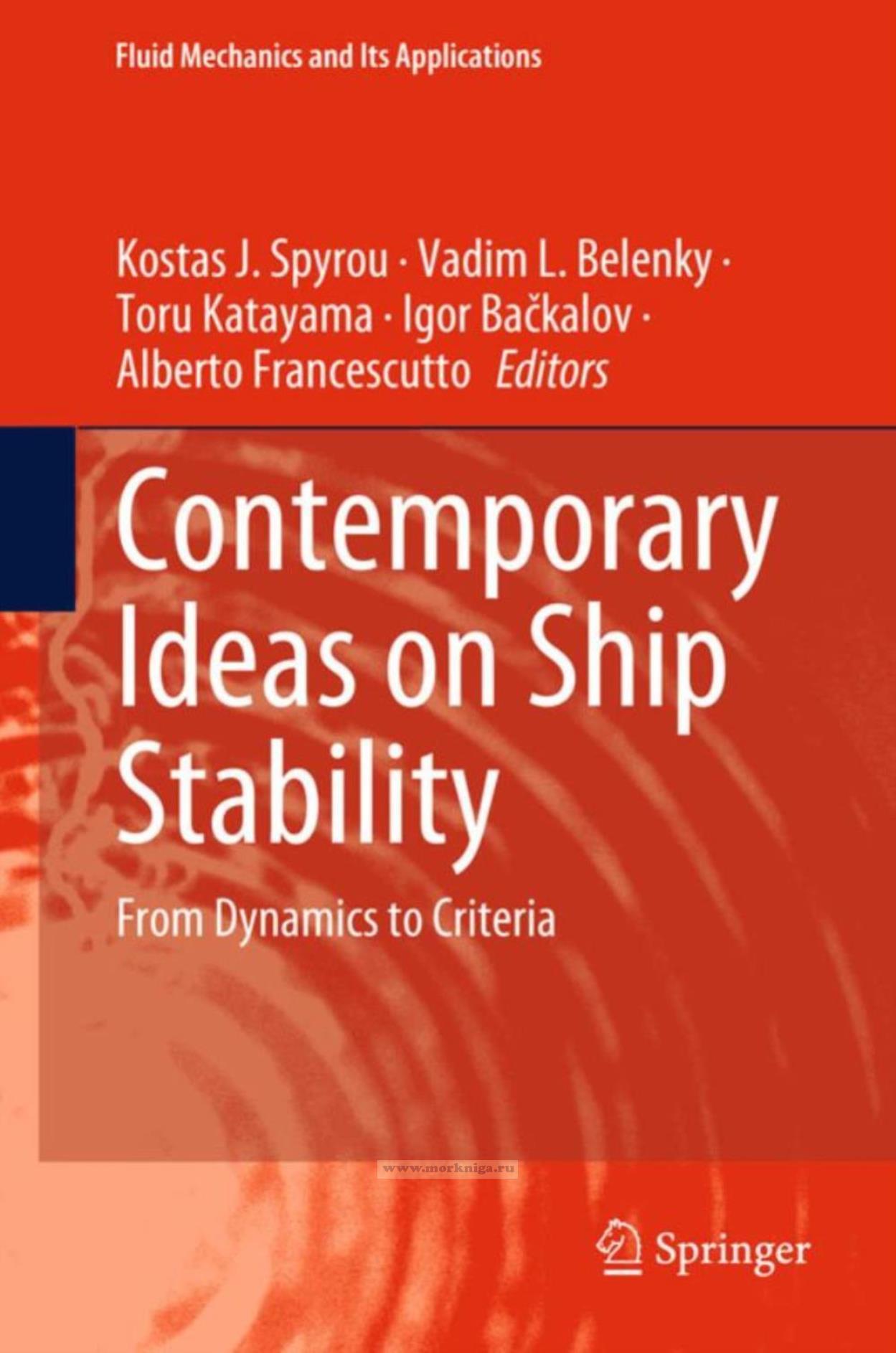Contemporary Ideas on Ship Stability/Современные представления об остойчивости судна
Книга на английском языке.
Ship stability has been investigated for so many years in order to achieve prevention of capsizing of intact and damaged ships. However, it has not yet been fully established for practical implementation. Ship stability requires us to deal with stochastic prediction problems of rare events in nonlinear dynamical systems under random environments. A ship has the restoring moment but only within a limited range, so the system should be regarded as strongly nonlinear. The wind and waves that the ship meets are random processes. Most currently operated ships are safe, but capsizing may still occur in some exceptional cases. In the case of other areas of ship dynamics, the situations are different. Seakeeping of ships under random environments can be modelled as linear or weakly nonlinear so that the linear superposition procedures can work well. Manoeuvering of ships deals with nonlinear systems, but the random environment is not essential. In ship stability, however, some room still remains for further discussion and challenge.
This new book is expected to be used by researchers of ship stability as well as by practical users of the international ship stability criteria recently developed by the International Maritime Organization (IMO), which are known as the Second Generation Intact Stability Criteria.
Contents
Introduction
Contemporary Ideas on Ship Stability: From Dynamics to Criteria-An Overview
Kostas J. Spyrou
Development of Second-Generation IMO Intact Stability Criteria The Second Generation Intact Stability Criteria-Achievements and Remaining Issues
Naoya Umeda and Alberto Francescutto
Safety Level of the IMO Second Generation Intact Stability Criteria
William S. Peters, Vadim Belenky, and Kostas J. Spyrou
Second Generation Intact Stability Criteria-Robustness and Consistency Analysis
Carsten Schroter, Marie Lutzen, Henrik Erichsen, Jorgen Juncher Jensen, Hans Otto Kristensen, Preben Hagelskjaer Lauridsen, Onur Tunccan, and Jens Peter Baltsersen
On Regulatory Consistency of Criteria for Dead Ship Condition and Pure Loss of Stability
William S. Peters and Vadim Belenky
Simplifications in Direct Stability Assessment
V. Shigunov
Regulatory Use of Nonlinear Dynamics: An Overview
William S. Peters, Vadim Belenky, and Kostas J. Spyrou
History of Stability Criteria Rahola Criterion and the Development of the Intact Stability Code
Alberto Francescutto
Improvements on Current Methods of Probabilistic Assessment of Ship Stability Study on Short-Term Prediction of Roll in Beam Sea
Toru Katayama, Mai Kankaku, Atsuo Maki, Kei Sugimoto, and Yusuke Fukumoto
An Efficient Formulation of the Critical Wave Groups Method for the Assessment of Ship Stability in Beam Seas
Panayiotis A. Anastopoulos and Kostas J. Spyrou
On Extending Multifidelity Uncertainty Quantification Methods from Non-rare to Rare Problems
Brendan Brown and Vladas Pipiras
Evaluation of Probabilistic Methods and Interpretation of Results Review of Probabilistic Methods for Direct Dynamic Stability of Ships in Random Seaway
Cleve Wandji
Verification, Validation and Accreditation in the Context of the IMO Second Generation Intact Stability Criteria and the Role of Specific Intended Uses in This Process
Arthur M. Reed
Statistical Validation of the Split-TimeMethod with Volume-Based Numerical Simulation
Kenneth Weems, Vadim Belenky, Bradley Campbell, and Vladas Pipiras
Effectiveness of the Generalized Pareto Distribution for Characterizing Ship Tendency for Capsize
Panayiotis A. Anastopoulos and Kostas J. Spyrou
Envelope Peaks Over Threshold (EPOT) Application and Verification
Bradley Campbell, Kenneth Weems, Vadim Belenky, Vladas Pipiras, and Themis Sapsis
Interpretation of Results of Numerical Simulation
Arthur M. Reed
Parametric Roll, Operational Measures and Stability Monitoring A Case Study on Operational Measures for Avoiding Parametric Rolling
Hirotada Hashimoto, Yuuki Taniguchi, and Michio Fujii
Wave Radar Application to the Simplified Parametric Roll Operational Guidance at Actual Sea
Takehiro Yano, Naoya Umeda, Keiichi Hirayama, Mitsunori Baba, and Masahiro Sakai
On the Application of Artificial Neural Networks for the Real Time Prediction of Parametric Roll Resonance
Marcos Miguez Gonzalez, Vicente Diaz Casas, Fernando Lopez Pena, and Luis Perez Rojas
Application of Real-Time Estimation Techniques for Stability Monitoring of Fishing Vessels
Lucia Santiago Caamano, Marcos Miguez Gonzalez, Roberto Galeazzi, Ulrik D. Nielsen, and Vicente Diaz Casas
Real-Time Estimation of Natural Roll Frequency for the Stability Guidance of Fishing Vessels
Marcos Miguez Gonzalez, Gabriele Bulian, Lucia Santiago Caamano, Sandra Allegue Garcia, and Vicente Diaz Casas
Surf-Riding and Broaching-to Estimates of the Probability of Surf-Riding in Irregular Seas
Kostas J. Spyrou, Nikos Themelis, and Ioannis Kontolefas
Abnormal High Speed Ship Motions in Two-Frequency and Multi-Frequency Following Waves
Kostas J. Spyrou, Ioannis Kontolefas, and Nikos Themelis
Critical Distance on a Phase Plane as a Metric for the Likelihood of Surf-Riding in Irregular Waves
Vadim Belenky, Kostas Spyrou, and Kenneth Weems
Modeling Broaching-to and Capsizing with Extreme Value Theory
Vadim Belenky, Kenneth Weems, Kostas Spyrou, Vladas Pipiras, and Themistocles Sapsis
Roll Damping Estimation of Force Coefficients for Bilge Keel and Skin Friction Roll Damping of Ships by CFD Simulations
Sven Wassermann and Moustafa Abdel-Maksoud
Study on Bilge Keel Component of Roll Damping for Non-periodic Motion
Jun Umeda, Toru Katayama, Hirotada Hashimoto, and Burak Yildiz
On Application of Standard Methods for Roll Damping Prediction to Ships with High Block Coefficient
Stefan Rudakovi’c and Igor Backalov
A Pragmatic Approach to Roll Damping
Jakub Cichowicz and Dracos Vassalos
Damaged Stability Regulatory, Design, Operational and Emergency Response Measures for Improving the Damage Survivability of Existing RoPax
Dracos Vassalos, Evangelos Boulougouris, Luis Guarin, and Andrzej Jasionowski
The Inertia Contributions Due to Floodwater Mass
Gyeong Joong Lee, Arthur M. Reed, Frans van Walree, Andrew Peters, Paola Gualeni, Toru Katayama, and WenYang Duan
Air Pressure Scale Effects During Damage Model Tests
Gyeong Joong Lee, Arthur M. Reed, Frans van Walree, Andrew Peters, Paola Gualeni, Toru Katayama, and WenYang Duan
A Framework for Probabilistic Damage Stability Assessment of Passenger Ships Considering Collision, Grounding and Contact Accidents
Gabriele Bulian, Mike Cardinale, George Dafermos, Eleftheria Eliopoulou, Alberto Francescutto, Rainer Hamann, Daniel Lindroth, Henning Luhmann, Pekka Ruponen, and George Zaraphonitis
Cruise Ship Survivability inWaves
Georgios Atzampos, Dracos Vassalos, Jakub Cichowicz, Donald Paterson, and Evangelos Boulougouris
Model Experiments Overview of Model Test Procedures for Stability Under Dead Ship Condition and Pure Loss of Stability in Astern Waves
Naoya Umeda, Daichi Kawaida, Yuto Ito, Yohei Tsutsumi, Akihiko Matsuda, and Daisuke Terada
Model Experiments of an Offshore Supply Vessel Running in Astern Waves
Naoya Umeda, Sreenath Subramaniam, Aqmil Alway, Akihiko Matsuda, Atsuo Maki, Satoshi Usada, and Daisuke Terada
Characteristics of Capsizing Phenomena of Fishing Vessels
Akihiko Matsuda, Daisuke Terada, and Hirotada Hashimoto
Accident Investigation Experimental Investigations into Accidents of Two Japanese Fishing Vessels
Harukuni Taguchi, Akihiko Matsuda, and Kuniaki Shoji
Cargo Liquefaction Liquefaction of Sand and Olive Pomace Cargo and Its Effect on the Stability of a Bulk-Carrier
I. A. Koromila, C. C. Spandonidis, and K. J. Spyrou
Offshore Structures Experimental and Numerical Investigation n Parametrically-Excited Motions of a Mono-Column Platform inWaves
Claudio A. Rodriguez, Julio C. F. Polo, and Marcelo A. S. Neves
Special Craft Validation of Simulation Tools for a RHIB Operating in Heavy Seas
Frans van Walree and William L. Thomas
Impulsive Loads on and Water Ingress in a Landing Craft: Model Tests and Simulations
F. van Walree and D. Sgarioto

